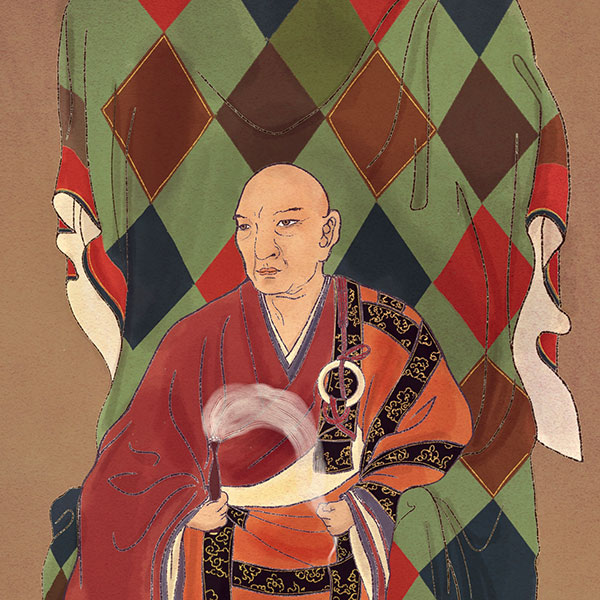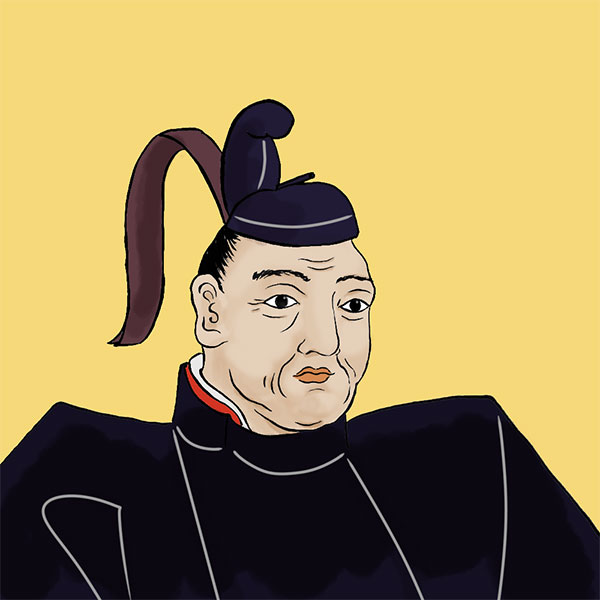Laws of the Imperial Court and the Nobles (2/2)The Edo Shogunate controlled the Imperial Court and the nobles

Laws concerning the Imperial Court and the Nobles
- Article category
- case file
- Incident name
- Laws for the Imperial Court and the Nobles (1615)
- place
- Tokyo
- Related castles

Edo castle
- people involved
At that time, the Imperial Court was in such a state that it could not hold the funeral or enthronement ceremony of the Emperor due to financial collapse that had continued since the Sengoku period. Sengoku warlords provided support (donations) as sponsors, and in return the warlords received official ranks and favors.
As the power of the Imperial Court weakened, a major scandal occurred. This was the "Inokuma Incident" in 1609. Inokuma Noritoshi, a handsome man who was said to be the second coming of Hikaru Genji, was caught up in adultery and orgies with multiple women in the Imperial Court (including the Emperor's concubines), involving nobles.
Inokuma Noritoshi was a trusted vassal of the emperor, but he had a bad reputation with women, and made advances on Nagahashi no Tsubone, a concubine of the then emperor Goyozei, which resulted in the angry emperor banishing him from Kyoto. Noritoshi fled to Osaka, but once the dust had settled, he secretly returned to Kyoto. Once again, he made advances on women one after another.
Furthermore, when she found out that the nobleman Hanazono Tadanaga was having an affair with the Emperor's concubine, Shintaisen (Hirohashi no Tsubone), she and other noble friends used the same tactics to hold orgies with the Emperor's concubines and other court ladies. When Emperor Goyozei found out about this, he was furious and ordered the death penalty for those involved.
Meanwhile, the shogunate, upon learning of the incident, ordered the Kyoto Shoshidai to investigate, and ITAKURA Katsushige and others began the investigation. Due to the large number of people involved and a petition from the emperor's birth mother requesting lenient treatment, Tokugawa Ieyasu intervened and persuaded the emperor. The main culprit, Noritoshi, was beheaded, but the sentences of the others involved were reduced to exile or other terms.
The shogunate had overturned the Emperor's decision, and Emperor Goyozei was so angry that he hinted at abdicating, but the shogunate refused because his younger brother, Prince Hachijo Toshihito, was Toyotomi Hideyoshi's adopted son. Emperor Goyozei eventually accepted the wishes of the Edo shogunate two years later and abdicated in favor of his son, Emperor Gomizunoo. Incidentally, Tokugawa Hidetada's daughter, Tokugawa Kazuko, was the consort of Emperor Gomizunoo.
In addition to this major scandal, there was also a struggle for hierarchy between the nobles and the princes, and the Imperial Court was in a state of chaos. The Imperial Court wanted to somehow restore calm, while the shogunate wanted to seize the opportunity to control the Imperial Court and the nobles, which led to the issuance of the Imperial Court Laws and the Nobles Act.
The Purple Robe Incident - What happened if you broke the laws of the Imperial Court and the Nobles?
The Imperial Court and Nobles Laws were enacted in this way, but the Edo Shogunate used these laws to put pressure on the Imperial Court and overturned the Emperor's decision in the "Purple Robe Incident" that took place from 1627 to 1629. Article 16 of the Imperial Court and Nobles Laws stated that purple robes should not be given out indiscriminately.
Originally, purple robes were purple robes given to virtuous monks and nuns by imperial permission from the emperor. The monks and nuns who received them, or the temples they belonged to, were required to pay a fee to the imperial court, making them a valuable source of income for the court. For this reason, the excessive production of purple robes became a problem during the period when the Imperial Court and Nobles Law was enacted.
Even after the Imperial Court and Court Nobles Law was issued, Emperor Gomizunoo continued to give purple robes to a dozen monks without checking with the shogunate. In July 1627 (Kan'ei 4), Tokugawa Hidetada, who reigned as taigosho (great general), pointed out that this was a violation of the law and ordered the invalidation of the imperial charter and the confiscation of the purple robes of those violating the law. Incidentally, this was already the time of the third shogun, Tokugawa Iemitsu, but a diarchic system of taigosho and shogun was in operation.
Emperor Gomizunoo and the Imperial Court opposed this. Temples such as Takuan Sobo of Daitokuji Temple and Togen Eto of Myoshinji Temple submitted a letter of protest to the shogunate the following year. In response, the shogunate compromised and agreed to partially accept the imperial edict, but the shogunate continued to protest. As a result, in 1629, the shogunate exiled Takuan Sobo to Kaminoyama in Dewa Province (present-day Kaminoyama City, Yamagata Prefecture), and Togen Eto and others to Hirosaki Domain in Okutsugaru (western Aomori Prefecture), and the people involved were exiled one after another.
As for those involved in the Purple Robe Incident, the shogunate later relented and pardoned them following the death of Tokugawa Hidetada in 1632.
Emperor Gomizunoo abdicates in protest
In this way, the Edo Shogunate demonstrated its power to overturn the Emperor's imperial charter. Emperor Gomizunoo was furious about this. He expressed his intention to abdicate several times in protest, but the Shogunate would not allow it. Meanwhile, Tokugawa Iemitsu's wet nurse, Fuku, did something wrong. In October 1629 (6th year of the Kan'ei era), despite being the daughter of a samurai family with no rank or position, she used a trick to marry her foster father's son, Sanjonishi Sanejyo, and become the daughter of the noble Sanjonishi family, thus gaining an audience with the Emperor.
At this time she was given the rank of Junior Third Rank and the title of "Kasuga no Tsubone", but the Emperor's anger finally exploded at this rather forced audience. As a sign of protest against the shogunate, he made the second princess, Onna Ichinomiya (daughter of Tokugawa Kazuko), Princess Okishi (proclaimed as an Imperial Princess), and then suddenly abdicated the throne to Princess Okishi on November 8th. Of course, there was no notice to the shogunate. However, Emperor Gomizunoo continued to hold power by implementing cloistered rule.
The relationship between the Edo Shogunate and the Imperial Court had reached an unmanageable state, but it was Tokugawa Kazuko who stepped in at this time. She desperately mediated between her husband, Emperor Gomizunoo, who was hostile towards the Shogunate, and her father, Tokugawa Hidetada. Thanks to Kazuko's actions, the Shogunate eventually ratified the abdication in December. Hidetada may have been angry that his own grandson had become emperor.
In September of the following year, 1640, Princess Okishi, who was only seven years old, ascended to the throne. Empress Meisho was born, the first female emperor in 859 years since Emperor Shotoku in the Nara period. On this occasion, the shogunate dismissed Nakanoin Michimura, the Buke Denso, and asked the Imperial Court to appoint Hino Sukekatsu in his place, intervening in the personnel affairs of the Buke Denso, who acted as a liaison between the shogunate and the Imperial Court. They also asked the Five Sekke to convey their opinions to the Emperor and to take responsibility for supervising the nobles' academic studies and their observance of the Imperial Court and Court Laws. These measures led to a growing awareness among the nobles that they needed to "obey the Imperial Court and Court Laws."
Subsequently, the shogunate came to recognize Emperor Gomizunoo's cloistered rule after Tokugawa Iemitsu went to Kyoto in 1634, and the relationship between the shogunate and the imperial court, which had been tense for a time, began to improve.
Re-read the article on the Imperial Court and Court Nobles Laws
- people involved

- WriterNaoko Kurimoto(Writer)I am a former travel industry magazine reporter. I have loved history, both Japanese and world history, since I was a child. I usually enjoy visiting temples and shrines, especially shrines, and often do ``pilgrimages to sacred places'' themed around historical figures. My favorite military commander is Ishida Mitsunari, my favorite castle is Kumamoto Castle, and my favorite castle ruins is Hagi Castle. My heart flutters when I see the ruins of battle castles and the stone walls of castle ruins.





